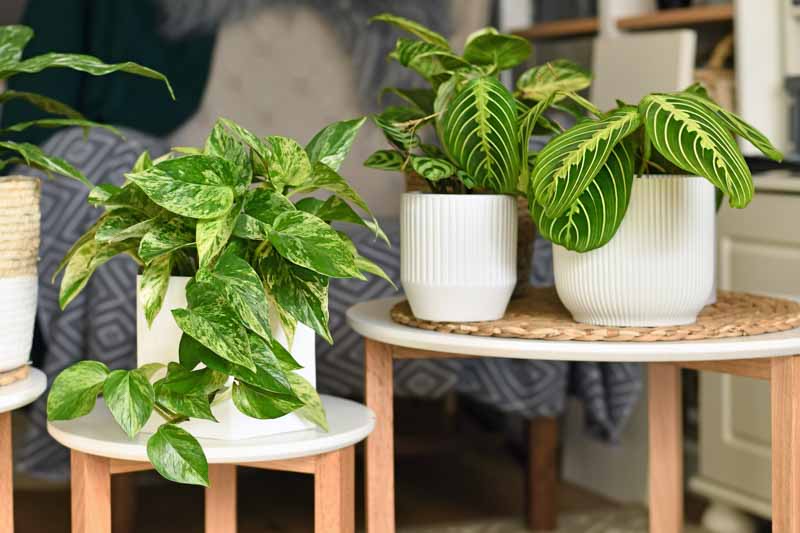Pothos or Devil's Ivy is an air-purifying, easy-to-grow houseplant that thrives with minimal care, enhancing indoor environments.
Pothos, also known as Devil’s Ivy, is a group of highly versatile and popular houseplants known for their attractive foliage and ease of care. These plants are often celebrated for their air-purifying qualities and adaptability to various indoor environments.
Pothos plants are characterized by their lush, trailing vines adorned with glossy, heart-shaped leaves. The foliage can vary widely among the species, from the solid green and golden variegated leaves of Epipremnum aureum to the deep green with silvery splashes of Scindapsus pictus, and the blue-green, sometimes fenestrated leaves of Epipremnum pinnatum.
Native: Epipremnum aureum and Epipremnum pinnatum are native to Southeast Asia and the Pacific Islands, thriving in tropical forests. Scindapsus pictus shares a similar native range, growing in the understory of tropical and subtropical forests. They belong to the arum family (Araceae), along with Zantedeschia (Calla Lily), Caladium (Angel Wing), Monstera (Swiss Cheese Plant), or Colocasia (Elephant Ear).
Plant Type and Habit: These are vining plants capable of climbing and trailing. They often climb trees and other structures using aerial roots in their natural habitat. Indoors, they are typically grown as trailing plants but can be trained to climb on supports.
Size: The vines of these plants can reach lengths of 4-40 feet (1.2-12 m). Their size can be easily managed through pruning, allowing them to fit into various indoor spaces from hanging baskets to climbing trellises.
Flowers: Flowering is rare for these plants when grown indoors. They can produce a spadix surrounded by a spathe, typical of the Araceae family, but this is seldom seen in household environments.
Foliage: The foliage is the main attraction, with each species offering something unique. Epipremnum aureum (Golden Pothos) is known for its golden variegation, Scindapsus pictus (Satin Pothos) for its silvery markings, and Epipremnum pinnatum (Dragon Tail Plant or Money Plant) for its blue-green leaves and potential for fenestration.
Hardiness: These plants are best suited for warm, humid indoor environments but can survive outdoors in USDA hardiness zones 10-12. They prefer temperatures between 60°F and 85°F and can suffer if temperatures drop below 50°F.
Uses: Beyond their decorative use, these plants are valued for their ability to purify the air, removing toxins such as formaldehyde and benzene. They are versatile and capable of adapting to various light conditions, making them suitable for many indoor settings.
Toxicity: Pothos plants are toxic to humans and pets if ingested, causing mouth and stomach irritation and potentially leading to vomiting.
Invasiveness: In tropical and subtropical regions where conditions are ideal, these plants can become invasive if not managed properly, potentially overtaking native vegetation.

Marble Queen pothos and prayer plant
Pothos plants offer a myriad of benefits that extend beyond their aesthetic appeal. Here’s a look at the advantages of incorporating Pothos into your indoor spaces:
One of the most celebrated benefits of Pothos plants is their ability to purify indoor air. Research, including the famous NASA Clean Air Study, has shown that Pothos can remove common household toxins such as formaldehyde, benzene, and xylene from the air, contributing to a healthier living environment.
Pothos plants are renowned for their hardiness and low maintenance requirements. They can thrive in a variety of lighting conditions, from low to bright, indirect light, and can tolerate irregular watering schedules. This resilience makes them ideal for both novice gardeners and those seeking fuss-free greenery.
With their trailing vines and lush, variegated leaves, Pothos plants add a touch of natural beauty to any indoor setting. They can be styled in numerous ways—hanging from baskets, climbing on trellises, or simply draped atop shelves—making them versatile additions to home decor.
By releasing water vapor during transpiration, Pothos plants can help increase indoor humidity levels. This is particularly beneficial in dry climates or environments with artificial heating, where dry air can be problematic for both human health and the condition of other indoor plants.
Interacting with and caring for plants, including Pothos, has been shown to reduce stress, enhance mood, and improve concentration and productivity. The presence of greenery indoors can create a more calming, restorative environment, promoting mental well-being.
Pothos plants are incredibly easy to propagate from stem cuttings, allowing plant enthusiasts to easily expand their collection or share with friends. This ease of propagation ensures that the benefits of Pothos plants can be widely enjoyed with minimal effort.
Pothos’s ability to adapt to various light conditions, including low-light environments where many other plants might struggle, makes it an excellent choice for spaces away from natural light sources, such as offices or interior rooms.
Create a membership account to save your garden designs and to view them on any device.
Becoming a contributing member of Gardenia is easy and can be done in just a few minutes. If you provide us with your name, email address and the payment of a modest $25 annual membership fee, you will become a full member, enabling you to design and save up to 25 of your garden design ideas.
Join now and start creating your dream garden!
Create a membership account to save your garden designs and to view them on any device.
Becoming a contributing member of Gardenia is easy and can be done in just a few minutes. If you provide us with your name, email address and the payment of a modest $25 annual membership fee, you will become a full member, enabling you to design and save up to 25 of your garden design ideas.
Join now and start creating your dream garden!